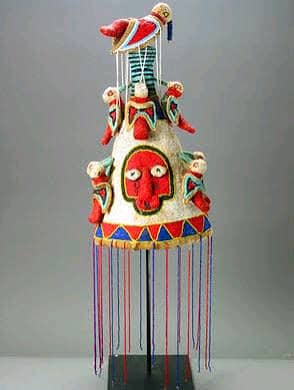The Oba's Crown (Adé)
The Oba's crown, referred to in Yoruba as Adé or Adé ńlá (“big crown”), is the highest symbol of authority, sacredness, and divine sanction in Yoruba kingship. It is richly decorated with beads and worn exclusively by kings (Obas) in Yorubaland. The Adé, alongside the Òpá Ase (staff of authority) and Odigba/Ejigba (beaded royal collar), symbolizes divine rule, ancestral connection, and cultural legitimacy.
Description
Yoruba crowns are elaborate, beaded, conical headpieces with long, beaded veils that obscure the face of the king. This veiling tradition signifies the monarch's transformation from an individual into a symbol of the dynasty—a mystical, generalized being representing continuity of leadership.
According to Robert F. Thompson:
“The crown incarnates the intuition of royal ancestral force, the revelation of great moral insight in the person of the king, and the glitter of aesthetic experience.”
Types of Crowns
- Adé / Adé ńlá: The grand, sacred crown worn by an Oba.
- Akoro: Smaller coronets worn by lesser chiefs (e.g., Baale, Oloja) who are not permitted to wear an Adé. These may contain feathers instead of bird figures.
Usage and Significance
Upon coronation, the Oba is consecrated and must not reveal his face to the public, hence the necessity of the beaded veil. Every Adé typically features:
- Bird motifs on the top or sides.
- Stylized beaded faces, representing:
- The king’s lineage.
- The monarch’s omnipresence and ancestral connection.
- Spiritual sight or all-seeing power.
The faces and birds often reference Odùduwà, the mythic progenitor of the Yoruba, symbolizing shared destiny and unity with past rulers.
Symbolism of the Bird
The bird atop the crown is deeply symbolic:
- Represents the mythical bird that helped Odùduwà form land in Ilé-Ifè.
- Symbolizes the king as an intermediary between heaven and earth.
- Reflects female mystical power (àṣẹ) given by Olódùmarè, empowering kings to channel both masculine leadership and archetypal feminine strength.
- Supports the tradition that the Ìyá Oba (King's Official Mother) crowns new Obas in some Yoruba towns.
Historical Context
The origin of the Adé is traced to Ilé-Ifè, regarded as the cradle of Yoruba civilization. Two traditions surrounding its spread:
- Odùduwà distributed crowns to his sons to establish kingdoms.
- His sons stole the crowns and founded their realms, paralleling the fragmentation of the Oyo Empire.
Today, every Yoruba king traces their legitimacy to Ilé-Ifè and Odùduwà.
Crown Variations
Other crown types reflect personal or colonial influence:
- Oríkògbófo: Personalized styles including:
- Abetí ajá (“dog-eared”) masks.
- Pillbox hats.
- European-style crowns resembling lawyers' wigs.
Babatunde Lawal explains that wig-like crowns emerged during colonial periods to signify the king’s advocacy role for his people amidst declining political power.
Beads and Their Significance
Beads are a sacred symbol in Yoruba culture:
- Historically made in Ilé-Ifè, later imported (e.g., red jasper from Litingo, modern colored beads from England).
- Worn by only select individuals: kings, chiefs, diviners, priests, etc.
- Beads carry spiritual, social, and aesthetic significance.
Symbolism of Beads
- Associated with àṣẹ (divine power).
- Red and white beads signify Shango, god of thunder — both punishing and healing.
- Beads represent:
- Continuity (like the ancestral bundle of sticks).
- Protection and revelation (of inner power and status).
- Unity and solidarity through threading.
Cultural and Ritual Roles
- The Oba, veiled by his Adé, transcends individuality and embodies the collective soul of the kingdom.
- The crown is an orisa (deity) itself in some Yoruba belief systems, linking the king's òrí inú (inner head) with past rulers.
- Faces and birds on the crown emphasize divine guidance, insight, and legitimacy.
Key References
- Robert F. Thompson: African Art in Motion
- Babatunde Lawal: The Gelede Spectacle
- Yoruba oral history and mythology surrounding Odùduwà and Ilé-Ifè.
